Pictures and facts about a new animal each day (almost). Send me suggestions and ask me questions.
Don't wanna be here? Send us removal request.
Photo
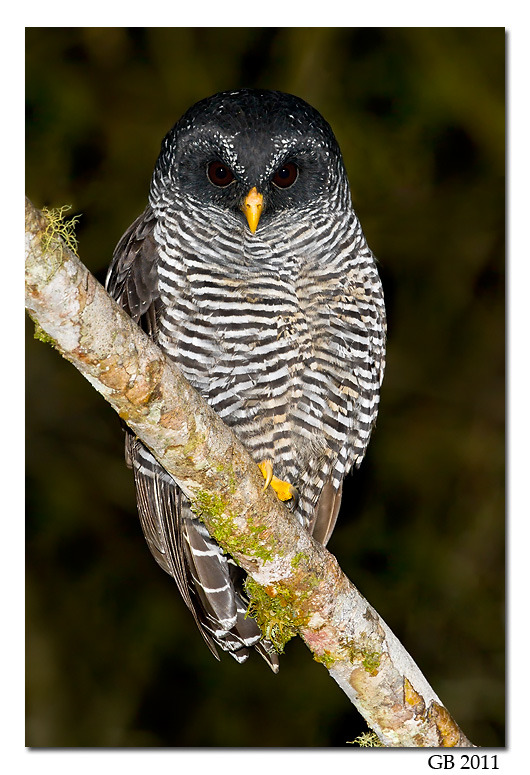
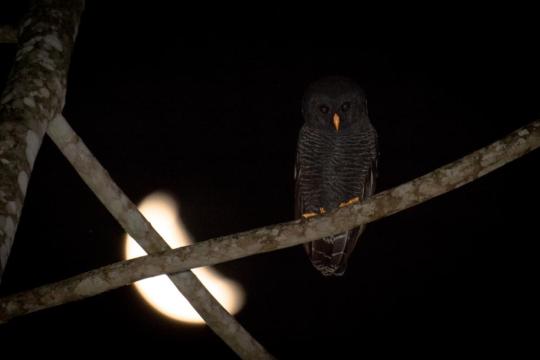
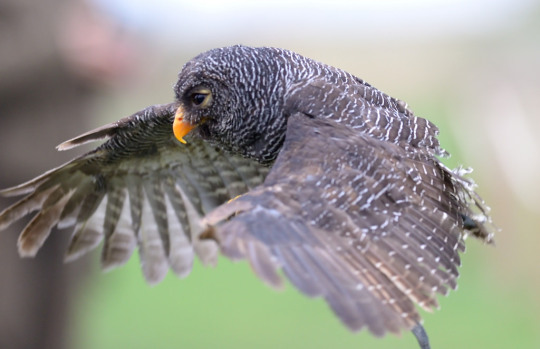
Spooktober Candy Corn Owl
Black-Banded Owl (Strix huhula/Ciccaba huhula)-
This grumpy owl lives in the tropical and subtropical forests throughout the northern and central regions of South America. In the night, it is extremely difficult to spot this owl, aside from its bright orange beak and feet.
Like most owls, they hunt at dusk and feed mostly on insects, small vertebrae. Males and females have distinctly different voices. Males use lower, short and repeated hoots, while females have higher pitched drawn out calls.
Listen to these and other owl hooting patterns here.
Photos: (top) (middle) (bottom)
#black-banded owl#black banded owl#strix huhula#owl#Ciccaba huhula#animal today#facts#spooktober#halloween
118 notes
·
View notes
Photo




Spooktober
Vampire Flying Frog (Rhacophorus vampyrus)-
The small nocturnal tree frog can be found in the rain forests of Vietnam. It has large, webbed feet that allow it to glide for a short time. Though the adult frog has no visible teeth, the name “vampire” comes from unique keratin hooks in the mouth of the tadpole.
To hide their young, females will lay eggs in water filled trees or stumps. Because of the tadpoles’ small and secluded nest, there is little to no food source. Mother frogs make up for this by providing the tadpoles with nutrient rich, unfertilized eggs. The small fangs and large mouths help the tadpoles to latch on and swallow large and slippery eggs.
Photos: (top left) (top right) (bottom left) (bottom right)
#vampire flying frog#vampire tadpole#tree frog#flying frog#frog#amphibian#anura#animal today#facts#spooktober
55 notes
·
View notes
Photo








Spooktober All dressed up for the costume party
Batesian Mimicry- A trait in which an animal has evolved to mimic the appearance of another (toxic or poisonous) animal for protection.
Hemeroplanes Triptolemus moth larvae-
This moth caterpillar has an effective adaptation that makes it look just like a tree snake. When threatened, it can narrow its false eyes to mimic a glaring snake. The larvae will even make striking motions to startle predators.
Juvenile Blackspotted Sea Cucumber (Bohadschia graeffei)-
The blackspotted sea cucumber’s juvenile stage leaves it vulnerable, so it takes on the appearance of the toxic sea slug, Phyllidia varicosa . As it matures, it grows to about a foot long and loses its bright coloration, but is then able to produce its own toxins.
Ladybird-Mimic Spider (Paraplectana tsushimensis) -
Ladybird Beetles (Coccinella septempunctata) produce a foul tasting alkaloid toxin. By mimicking one, this spider is safe from most predators.
Scorpion Tailed Gecko (Pristurus carteri)-
This small Arabian gecko sways and curls its tail to communicate with one another. In defense, they will curl and strike with their tails, like a scorpion.
#mimicry#animal dress up#ladybird-mimic spider#blackspotted sea cucumber#scorpion tailed gecko#hemeroplanes triptolemus#spider#sea cucumber#gecko#moth#larvae#caterpillar#camouflauge#animal today#facts#spooktober#animal mimic
196 notes
·
View notes
Photo


Spooktober She...she’s beautiful.
Wolftrap Anglers/Seadevils (Lasiognathus)-
Lasiognathus is a genus of a family of dreamers (Oneirodidae), the largest, but least known family of deep sea anglerfish. There are 6 species in this genus. These small fish have been discovered in deep, temperate waters worldwide.
Individual species can be identified through slight variations in the bioluminescent bait/lure, placement and size of the teeth, and orientation of the upper jaw’s premaxillaries. In all species, the upper jaw is much longer than the lower jaw, and the actual jaw is connected by skin, allowing it to fold over itself. When prey is lured close by the glowing bait, the upper jaw is brought down (similar to a goblin shark), teeth and all, completely covering the lower jaw, encasing its victim.
Like other deep sea anglerfish, the Lasiognathus exhibit extreme sexual dimorphism. Anglerfish males resemble small tadpoles, existing only to attach to a female to provide sperm. Only matured female Lasiognathus specimens have been collected, however it is difficult to identify male specimens of the same species.
Photos: (top) (bottom)
#wolftrap anglerfish#wolftrap seadevil#angler fish#deep sea#sea devil#snaggletooth anglerfish#lasiognathus#dreamer fish#fish#animal today#facts#spooktober
176 notes
·
View notes
Photo



Spooktober 2cute2spook
Spectral Bat / False Vampire Bat (Vampyrum spectrum)-
Unrelated to other large, carnivorous “false vampires” (lesser and greater false vampires, ghost bats, yellow winged bats, etc.), these bats are the only member of the genus Vampyrum. True vampire bats feed parasitically on the blood of other animals. False vampires actively hunt and kill prey.
Spectral vampires are the largest carnivorous bats, with wingspans upwards of 3 feet. Huge, dexterous wings and broad tail membrane allow them to carry heavy prey through trees and caves. During the night, they hunt small birds, mammals, other bats, and large insects. Spectral bats use echolocation to navigate. While hunting, they rely on their keen eyesight and smell to stalk their prey on silent wings, swooping in low to the ground for the kill. Due to their hunting and nesting habits, these bats are dependent on neotropical arboreal populations, usually near streams or rivers.
These bats mate for life, and the males are active in raising young. Parents will hunt and bring back food for their mate and pup. Males are also known to roost with his family wrapped in his wings.
Photos: (left) (right) (bottom)
#spectral vampire bat#spectral bat#false vampire bat#Linnaeus's false vampire bat#bat#Vampyrum spectrum#animal today#facebook#spooktober
520 notes
·
View notes
Photo





Spooktober Arachtober!
Harvestman spiders (Opiliones)- Family: Gonyleptoidea-
Although commonly known as harvestman spiders, this arachnid is not actually a spider. The closest relatives of the Opilione order are scorpions and mites (which often parasitize the harvestmen, visible in bottom right photo of a female Sadocus polyacanthus)
Unlike spiders harvestman have a “fused” body. It lacks the distinct segmentation between the cephalothorax and abdomen. Other major differences include the lack of both venom and silk glands, and having one pair of eyes, sometimes none at all. Their second, longest pair of legs act as “antennae”. In defense, they have ozophores that produce a smelly, noxious fluid. Males have simplified penises, a trait absent in all other arachnids (this isn’t a thing I actively look for in animals, it’s purely coincidental). Most species are omnivorous and nocturnal. Though their thorny bodies and gangly legs may look intimidating, they are quite small and harmless to humans.
The tropical Gonyleptoidea family is one of the largest families in the order Opiliones with over 2,500 species. Gonyleptidae are unique in size as well as the appearance and behavior of the males. The large, ventral spikes on the abdomen’s “shield”, used for bumper butts fighting, is only present in males (male and female comparison in last two photos). Male Gonyleptidae are also solely responsible for guarding the eggs.
Photos: (top) (second) (third) (left) (right)
#harvestman spider#opiliones#Laniatores#Gonyleptoidea#Propachylus#Sadocus#diptera#arachnid#bug#animal today#facts#spooktober#arachtober
175 notes
·
View notes
Photo


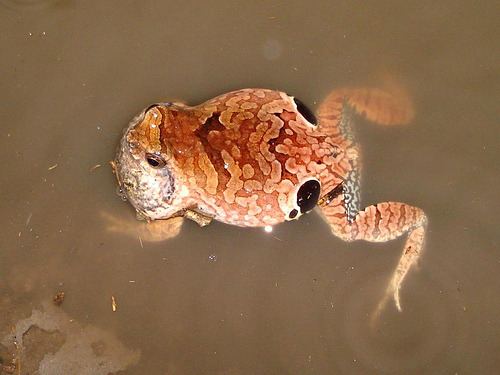
Spooktober Boo!
Cuyaba Dwarf Frog (Physalaemus nattereri or Eupemphix nattereri)-
This little frog is a common find in the ponds and grasslands of Brazil, Paraguay and Brazil.
Their main defense is the black spots on their rear ends. They can posture and inflate their bodies to make these eye spots look massive, and dissuade predators from approaching. If intimidation fails, the eye spots also contain macroglands (passive glands that activate via blood pressure levels) that secrete a foul tasting, milky toxin.
After rainfall, the maller males will group together and beep in chorus to attract females. Together, they will produce a foamy nest of thousands of eggs that can be shared with other pairs.
Photos: (top) (left) (right)
#butt eyed frog#cuyaba dwarf frog#physalaemus#amphibian#frog#leptodactylid#animal today#facts#spooktober
180 notes
·
View notes
Photo



Spooktober Dead eyes staring right at your deepest, darkest molecular structures.
Northern Giant Petrel (Macronectes halli)-
Along with it’s cousin, the Southern Giant Petrel, this bird is one of the few tube-nosed sea birds (albatross, petrels, and shearwaters) that will forgo their pelagic natures to scavenge on land to feed on carrion. They are also known to actively hunt and kill smaller birds. Male petrels will not share a carcass with females. Females are more pelagic and feed mostly on the surface of the ocean.
A tubenose’s bill is made up of several plates. In a petrel, the “beak tip” plate ends in a hooked point that is designed for tearing flesh and fighting for slippery fish, octopus or ship scraps. The tubed nostril helps them to get rid of excess salt water.
These birds feed almost like vultures, using their acute sense of sight and smell to locate meals. As they feed on carcasses, they shove their heads into the soft flesh and rip off whatever they can grab. They are quite gregarious and will fight off other birds who try to participate in the feeding. Their stomachs produce a type of fatty acidic oil that is used to feed chicks, as a food source for long flights, and to spit at predators.
Photos: (top) (middle) (bottom)
64 notes
·
View notes
Photo





Spooktober
Crocodile Snake Eel (Brachysomophis crocodilinus)-
These eels can be found in the shallows of tropical waters in the Indo-Pacific region, through Australia, and the coast of Japan. Crocodile snake eels have been found in bright orange red, spotted brown, pale skeleton white, or a mixture of any of these colors.
Male eels can grow to just under 4 feet long. They are called snake/worm eels because they have only very small fins near their heads, and a short dorsal fin running along their bodies. Only occasionally venturing out at night, the crocodile snake eel spends most of its time hiding in sandy reefs. With its snake like eyes and sensitive snout exposed just over the sand, it lies in wait to ambush prey. They have long, wide mouths and sharp, conical teeth that help to snatch slippery fish and octopus. The individual in the bottom right photo has attacked a fish too large, and died trying to swallow it.
Photos: (top) (left) (right) (bottom left) (bottom right)
#crocodile snake eel#henshaw's snake eel#reptilian snake eel#eel#Ophichthidae#marine eel#spooktober#animal today#facts
1K notes
·
View notes
Photo




Cream-Colored Giant Squirrel (Ratufa affinis)-
One of the largest giant squirrels, the cream-colored giant squirrel can grow up to just over 30 inches, including its ~17 inch tail. It is found in Southern Burma, Sumatra, Thailand and Malaysia, and is the only giant squirrel in Borneo.
There are 9 subspecies of this squirrel with a range of color variation, all of which branched from an almost entirely pale cream-colored giant squirrel (R. a.affinis, top left) that was first discovered in Singapore, but can no longer be found there. The 9 subspecies can vary from pale grey to red to black with red cheeks (R.a pyrsonota, bottom right), depending on the region.
Like most squirrels, they are diurnal and eat mainly seeds, but will also feed on fruit, bark, leaves, nuts, insects, and eggs. It lives in the lower forests, staying high in the canopy, using its heavy tail to balance its heavier body when eating and climbing. They are typically solitary, but have been recorded in pairs.
Photos: (top left) (top right) (bottom left) (bottom right)
#cream-colored giant squirrel#giant squirrel#cream colored giant squirrel#burma#sumatra#malaysia#mammal#arboreal#squirrel#ratufa#animal today#facts
67 notes
·
View notes
Photo
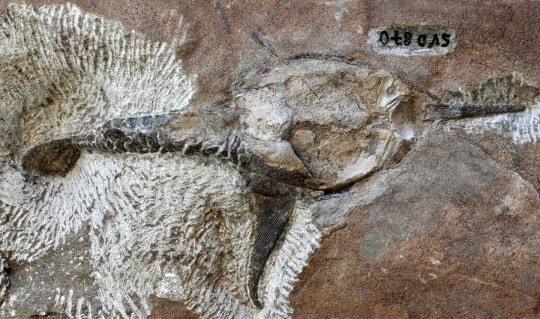
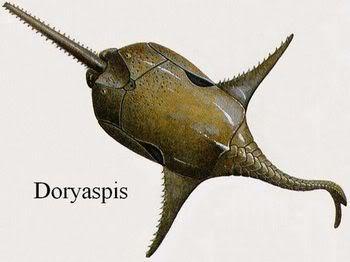
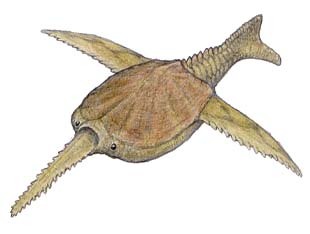
Dart Shield (Doryaspis nathorsti and Doryaspis arctica)-
This armored, jawless fish was discovered in Spitsbergen, Norway. They lived during the Devonian period, about 350 million years ago. Its most definitive feature is the large armored shield that covers most of its body. The main difference between the D. nathorsti and D. arctica is that the D. nathorsti (pictured above) toothy spikes running along its snout and the front of its extended lateral spines (branchial plates). The D. arctica is smaller and has no spikes.
This prehistoric fish had a long bony protrusion near its mouth, possibly to disrupt sediment to suction up whatever was hidden underneath. The saw-like “snout” ( the pseudorostrum) was actually an extension of its “chin” plate, rather than its “nose” (the rostrum), as seen on a modern day sawfish. It had a long, flexible tail with thick scales. Its downward curving branchial plates were thought to help it maintain level swimming.
Airplane fish Photos: (top) (bottom left) (bottom right)
#dart shield#doryaspis#doryaspis nathrosti#doryaspis arctica#prehistoric#devonian#fish#jawless fish#extinct#norway#animal today#facts
65 notes
·
View notes
Photo





Cypris Morpho (Morpho cypris)-
The genus, Morpho contains around 150 subspecies of butterfly that have iridescent blue ranging in almost a clear pearl (M. sulkowskyi) to a bright cobalt (M. rhetenor). These butterflies live in neotropical regions of South America. Most of the Morpho species display sexual dimorphism. The male morphos are typically more colorful, and the females are partially iridescent or entirely brown and yellow.
The Cypris Morpho males have vibrant blue and white wings. The larger females (second photo, bottom row) are a dark brown and tawny yellow from above. Their wings can be up to 14cm wide. From the ventral side, both genders look similar and have several ocelli. These eye spots are characteristic of all morphos. The brilliant wings are not actually pigmented blue, but instead, each scale is composed of rows of micro structures that reflect most light, including ultraviolet, causing the wing to appear blue. Males use their reflective wings to communicate from long distances (as they are territorial and solitary), and to confuse predators. The unique structure and layering of the shingle-like scales also help to absorb sun light, heat, repel water, and are self cleaning. Scientists and engineers are studying these wings in attempt to utilize them in solar panels, paper currency, and fabrics.
The cool guy at the bottom is a Cypris Morpho larvae. They smell like rotten butter and the hairs irritate skin. The larvae eat poisonous plants which carry on into the bodies of their butterfly forms. The chrysalis emit an ultrasonic sound to discourage predators.
Photos: (top) (second) (third left) (third right) (bottom)
#cypris morpho#morpho cypris#cypris morpho butterfly#butterfly#insect#caterpillar#colorful#iridescent#animal today#facts
32 notes
·
View notes
Photo



Octopus Squid (Octopoteuthis deletron)-
O. deletron, is a deep sea dwelling cephalopod and is under multiple scientific studies due to its handful of strange traits.
It is unique to the O. deletron to be (one of the?) only squid to have only eight arms and no tentacles. Babies (bottom left) lose their two tentacles as they mature. Light flashing photophores at the tips of the arms attract prey, and possibly mates. O. deletron is able to drop parts of its arms at will. The sharp “teeth” on its arms hook onto predators and prey. If needed, the squid can detach any arm at any length (unlike an octopus that drops the entire tentacle). Like a lizard tail, the arms grow back.
Also unusual among squid, the O. deletron sports a large penis. In the photos, o. deletron displays small white dots on near its mantle. These are sperm packets deposited by passing males. Since they are solitary and live in the deep sea, finding a mate is difficult. Whenever a male o. deletron meets another member of its species, it will deposit its sperm packets regardless of the gender of its companion.
Photos: (top) (bottom left) (bottom right)
192 notes
·
View notes
Photo



Coromandel’s Striped Gecko (Toropuku stephensi Coromandel or Hoplodactylus stephensi var. coromandel)-
Though geckos are a common sight in New Zealand, this particular species is the rarest gecko in New Zealand, and possibly in the world. It is so rare, and its range so small, that it was thought to be extinct until 1997. Some thought it to be a variation of the Stephen’s Island Striped Gecko, hence, the alternate scientific name: Hoplodactylus stephensi var. coromandel (var. meaning variation of the Stephen’s Island Striped Gecko).
Since its (re)discovery in 1997, it has taken over a decade to successfully find and breed these geckos. Most recorded information known is from observation of captive individuals. The latter two photos above show the difference between a male and female Coromandel’s striped gecko, the male being the more vivid (left) and the female slightly more muted (right).
Though striped geckos are not uncommon in New Zealand, both the stephensi geckos are unique in that they have a slight “wood grain” pattern running lengthwise along their bodies. It is particularly visible in the light stripes of the male. The coloration of these reptiles seems to vary from a tawny brown to an almost silver white.
Photos: (top) (bottom left) (bottom right)
#coromandel's striped gecko#stephen's island striped gecko#striped gecko#hoplodactylus#toropuku#gecko#reptile#animal today#facts
308 notes
·
View notes
Photo



Bridled Nail-tail Wallaby (Onychogalea fraenata)-
Also called a merrin or a flash jack (don’t look that up, or do- nsfw), it is characteristically named after a nail/spur like tip on its tail, possibly for more grip/traction. There are two other wallaby species that share the same spur- the Northern (common) and Crescent (extinct) nail-tail wallabies.
These small marsupials are found along the Eastern coast of Australia and were once thought to be extinct in the 1930s, and was rediscovered 40 years later. The species’ range was then put under the protection of private reserves and conservation projects to repopulate their numbers. They are now considered vulnerable.
Though a primarily solitary species, these wallabies are sometimes found grazing in groups. They are nocturnal, but they do like to sunbathe. In the night, they feed on succulents and soft leaved plants.
A unique trait to the bridled nail-tails is that they seem to have a more aggressive immune system than other macropods, allowing them to survive parasites, infections, viruses and other diseases.
Photos: (top) (bottom right) (bottom left)
#bridle nail tailed wallaby#nail-tailed wallaby#merrin#flash jack#marsupial#macropod#australia#animal today#facts
154 notes
·
View notes
Photo



Heaviside's dolphin (Cephalorhynchus heavisidii)-
Named after it’s discoverer, Captain Haviside, this dolphin is one of the smallest (just under 6 ft. long) of its order that can be found on the coast of Namibia. Though not uncommon, scientific research is lacking data on their reproduction, migration and population habits.
These dolphins are popular for boat tours and are known to bow-ride, sometimes keeping the company of kayaks. Usually found in small groups of 5, they can be found in pods of more than 10. They are active and fast swimmers that are often seen playing on the surface of the water. Although they typically breach and slap their fins on the water, they are also able to fall to the water without making a splash.
Because of their bow-riding habits, they used to be hunted frequently. Now, because they are coastal dwelling, they are commonly at risk from fishing equipment and pollution.
Photos: (top) (bottom left) (bottom right)
60 notes
·
View notes
Photo


Longisquama (Longisquama insignis)- Almost every speculation of the “Long Scales” appearance and behavior are based off an extremely small collection of fossils and limb fragments. The appendages resemble the shape of feathers with the rigidness of scales, but are neither. It may have grown to around 10 inches long, and the spines could have tripled the height of its body.
This small lizard’s fossils were discovered in Kyrgyzstan, Russia in the 1960′s and since then has been exposed to heavy research and debate. It is the only known species in its genus.
It used to be thought that there were two rows of the structures running along its back, and the animal would use them to glide. More recently however, it has been concluded that it had only one row and may have used them for display or to camouflage with vegetation. It is confirmed that these appendages grew out of the dinosaur’s vertebrae and were not a coincidental placement of plant fronds.
Photos: (top) (bottom)
108 notes
·
View notes